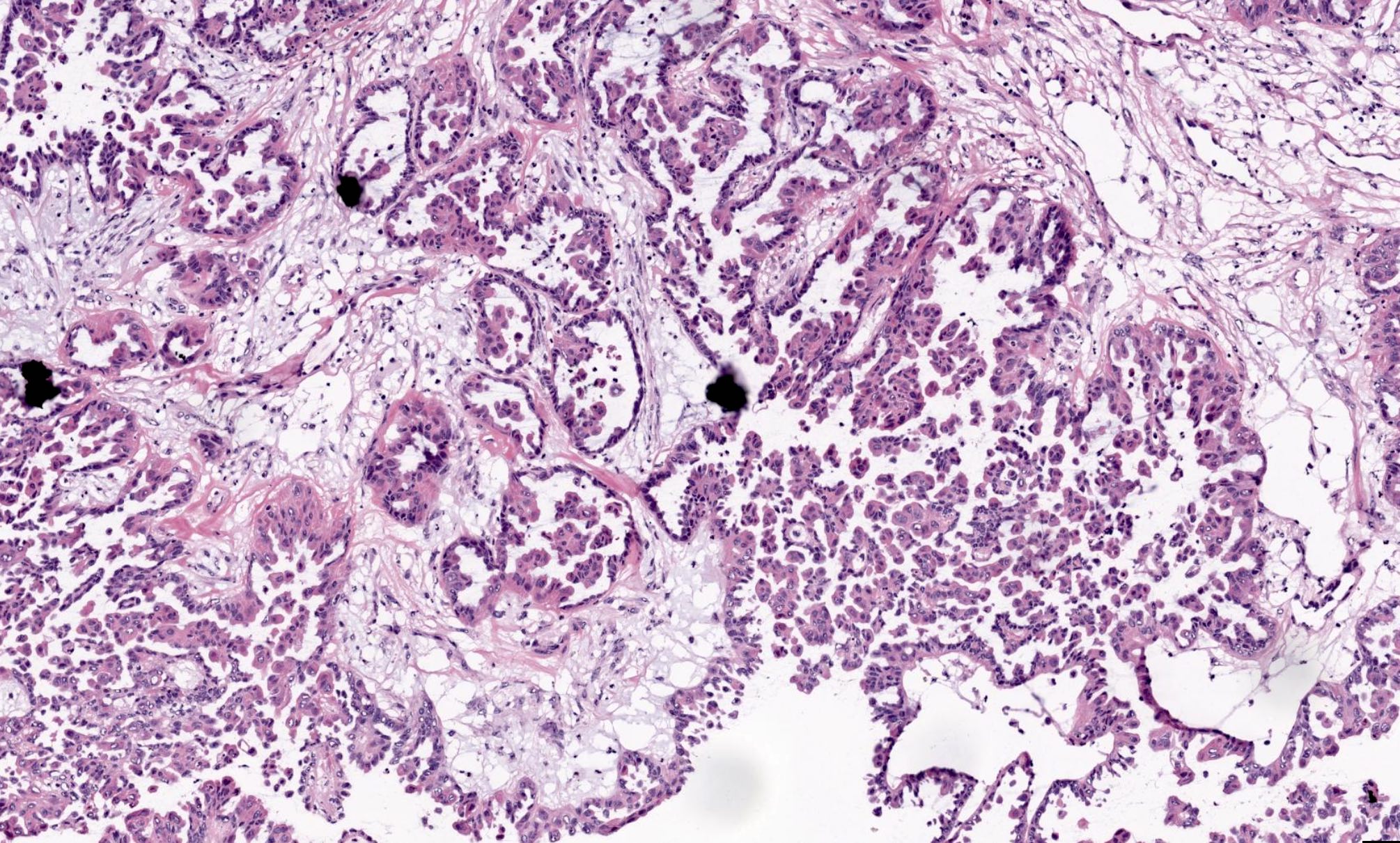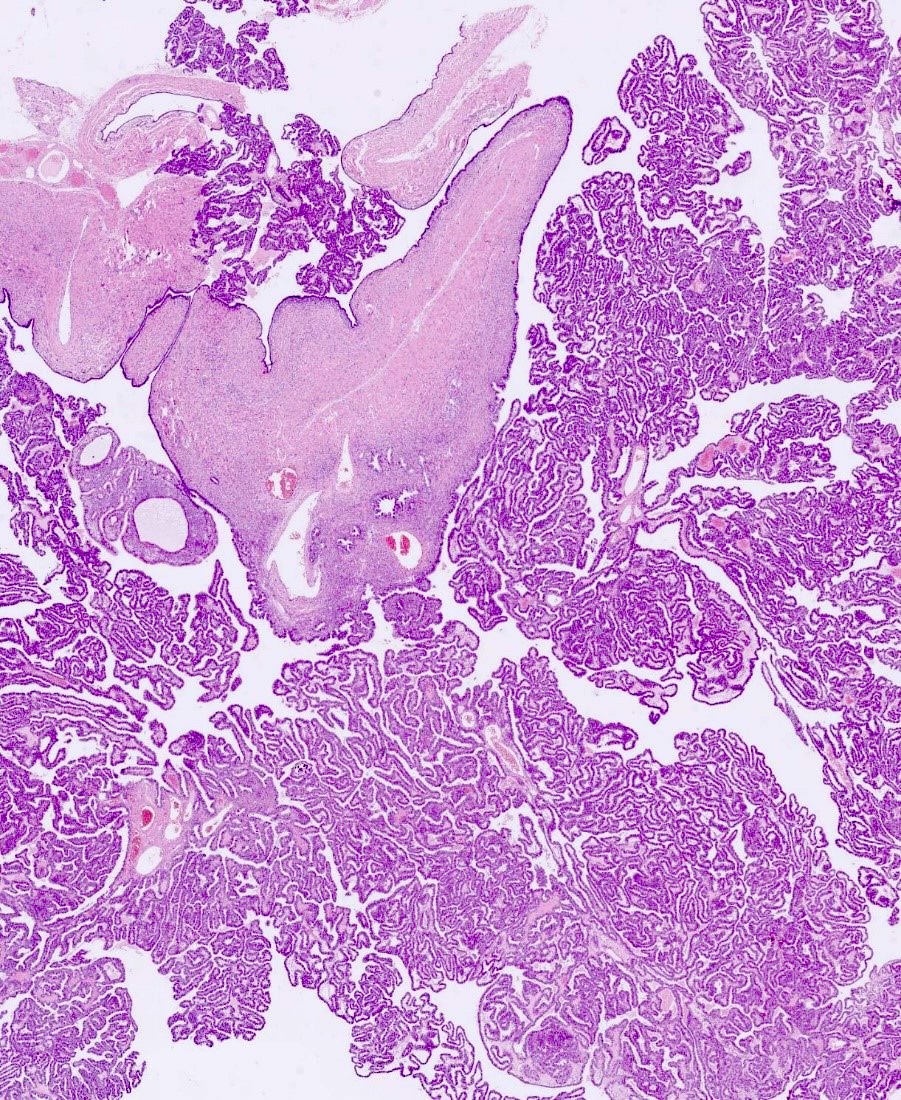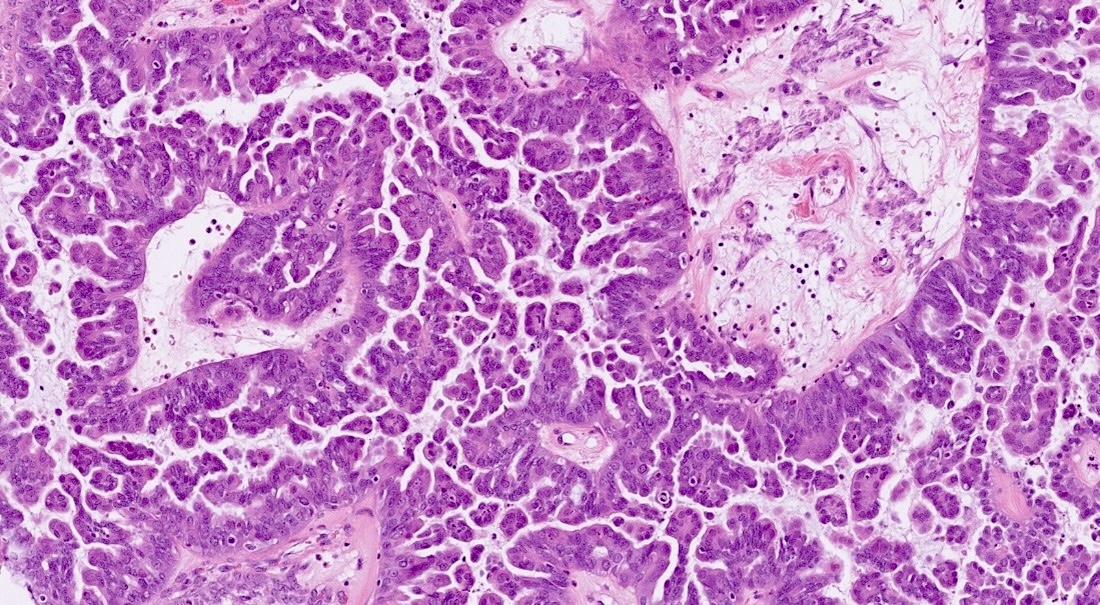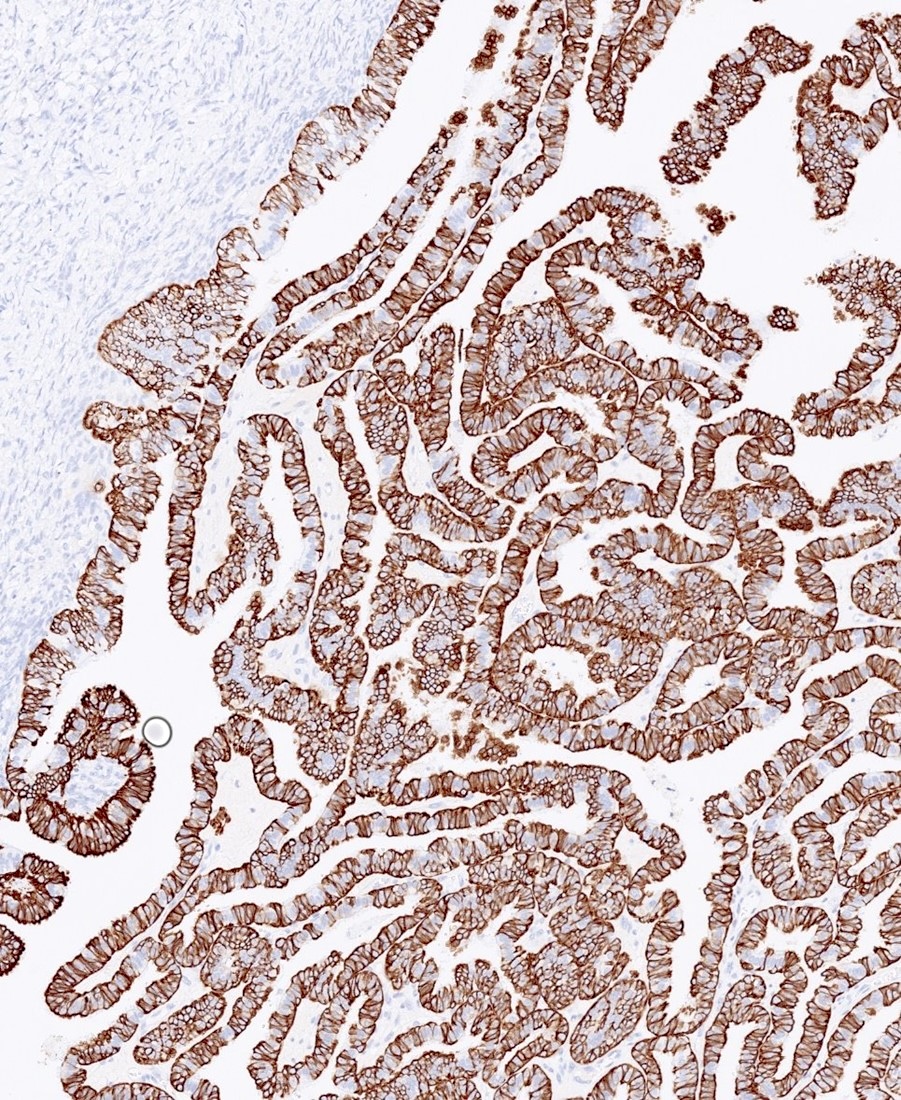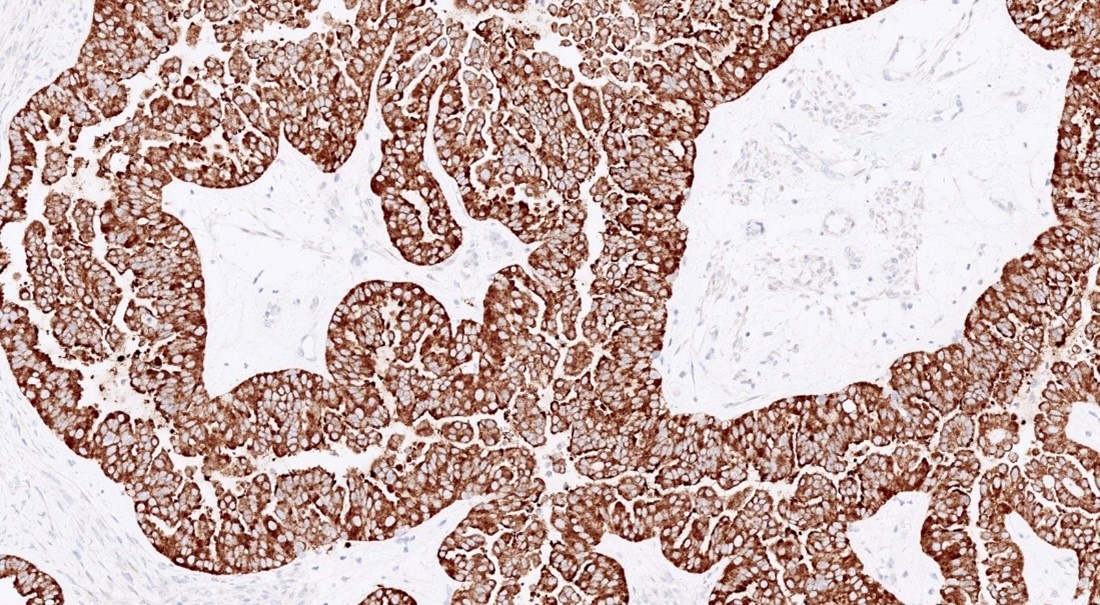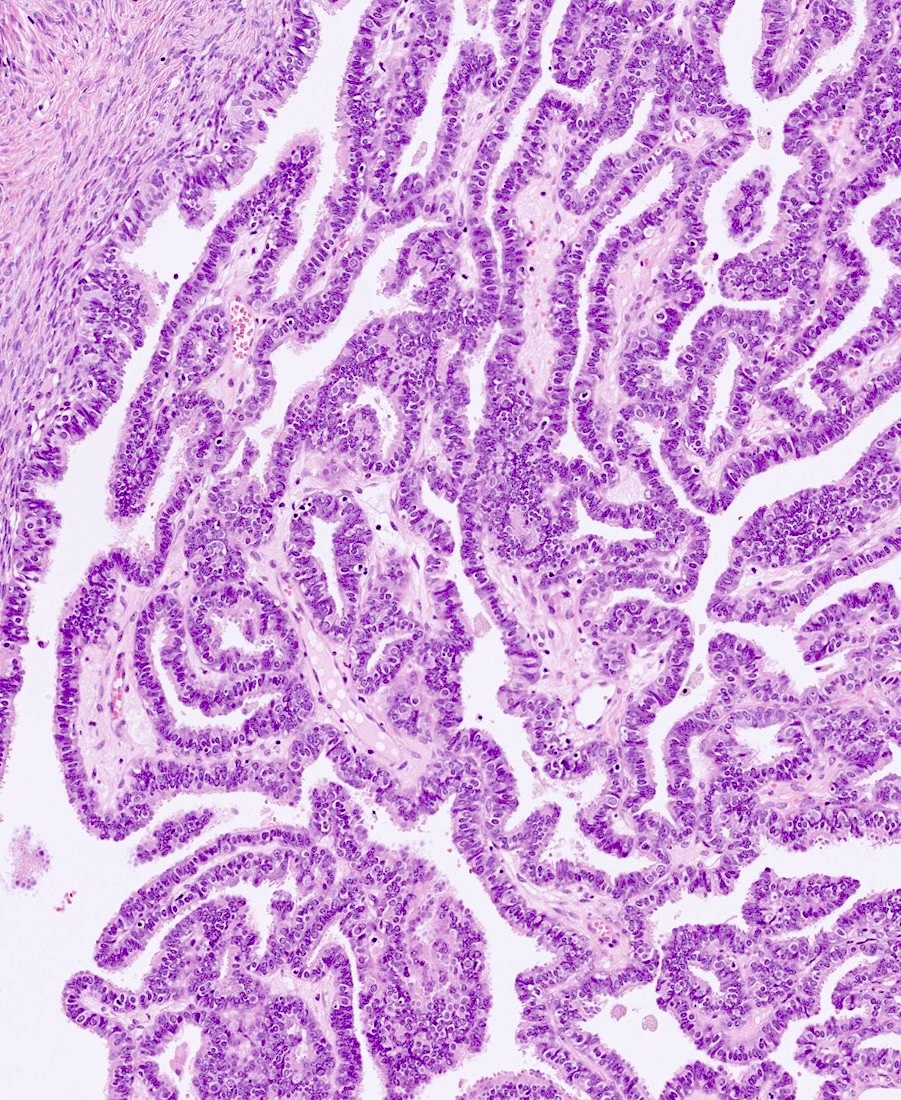Table of Contents
Definition / general | Essential features | Terminology | ICD coding | Epidemiology | Sites | Pathophysiology | Etiology | Clinical features | Diagnosis | Laboratory | Radiology description | Radiology images | Prognostic factors | Case reports | Treatment | Clinical images | Gross description | Gross images | Frozen section description | Frozen section images | Microscopic (histologic) description | Microscopic (histologic) images | Virtual slides | Positive stains | Negative stains | Sample pathology report | Differential diagnosis | Board review style question #1 | Board review style answer #1Cite this page: Hamilton C, Atwi D, Hassell LA. Serous borderline tumor. PathologyOutlines.com website. https://www.pathologyoutlines.com/topic/fallopianserousborderlinetumor.html. Accessed April 2nd, 2025.
Definition / general
- Serous borderline tumor (SBT) of the fallopian tube is a low grade, proliferative serous epithelial neoplasm that is by definition noninvasive (Pan Afr Med J 2019;32:129)
Essential features
- Serous borderline tumor arising in the fallopian tube is a rare entity with fewer than 20 cases in the literature
- Microscopically similar to SBT arising in the ovary, with numerous papillae of varying size arborizing down to smaller papillae
- Hobnailing may also be present
Terminology
- Serous borderline tumor is currently the sole recommended term for primary fallopian tumors
- Not recommended: atypical proliferative serous tumor (Am J Surg Pathol 2011;35:1605)
ICD coding
- ICD-O: 8442/1 - serous borderline tumor, NOS
- ICD-11: 2C74.Y & XH3ZK9 - other specified malignant neoplasms of fallopian tube & serous cystadenoma, borderline malignancy
Epidemiology
- Serous borderline tumor of the fallopian tube is a rare neoplasm with fewer than 20 cases reported in the literature (Arch Gynecol Obstet 2011;283:349)
- Age range is broad, from 22 to 83 years (BMC Cancer 2005;5:129)
Sites
- Fallopian tube
Pathophysiology
- Theorized to arise from papillary hyperplasia of the fallopian tube (Histopathology 2013;62:44)
- May similarly be related to BRAF V600E mutation as in serous borderline tumor of the ovary (J Natl Cancer Inst 2003;95:484)
Etiology
- Unknown
Clinical features
- Nonspecific; may be asymptomatic or may have abdominal pain (Obstet Gynecol Sci 2014;57:334)
Diagnosis
- Adnexal mass may be noted on routine gynecologic exam
- Ultrasound findings may reveal cystic mass near ovary
- On laparoscopy, dilated fallopian tube or hematosalpinx may be noted (BMC Cancer 2005;5:129)
Laboratory
- Generally, CA125 levels are normal (Pan Afr Med J 2019;32:129)
Radiology description
- Hypoechogenic cystic mass on ultrasound, sometimes with intramural papillary projections (Pan Afr Med J 2019;32:129)
Prognostic factors
- Prognosis is excellent with surgical removal (Clin Case Rep 2023;11:e7140)
Case reports
- 25 year old woman with lower abdominal pain and abdominal mass (Obstet Gynecol Sci 2014;57:334)
- 30 year old woman with a 1 year history of pelvic pain (Clin Case Rep 2023;11:e7140)
- 61 year old woman with a left fallopian paratubal cyst (Pan Afr Med J 2019;32:129)
Treatment
- Too few cases to determine optimal treatment; however, most commonly treated through conservative surgical management via salpingectomy or salpingo-oophorectomy for fertility preservation purposes
- At times includes hysterectomy for staging (Obstet Gynecol Sci 2014;57:334)
Gross description
- Received from surgery as cystic mass or distended fallopian tube
- Cut surface
- Multiloculated cystic mass
- Intralocular papillary projections
- Filled with serous fluid
- References: Obstet Gynecol Sci 2014;57:334, Pan Afr Med J 2019;32:129
Frozen section description
- Gross intraoperative evaluation
- Solid areas and papillary excrescences should be evaluated histologically
- Histologic intraoperative evaluation
- Bulbous papillae branching into smaller papillae on lower power
- Hobnailing or epithelial tufting
- Comparable to serous borderline tumor of the ovary
- Reference: Gynecol Oncol 2011;123:517
Frozen section images
Microscopic (histologic) description
- Serous borderline tumors of the fallopian tube closely resemble their ovarian counterparts
- Architecture
- Numerous papillae of variable size and width (Obstet Gynecol Sci 2014;57:334)
- These papillae occupy a variable extent of a cyst lined by pseudostratified epithelium
- Larger papillae arborize down to smaller papillae which terminate in epithelial clusters or single cells
- Hobnailing or epithelial tufting
- Cytologic features
- Ciliated cells that are cuboidal to columnar
- Up to moderate atypia: cellular enlargement, coarse chromatin, small nucleoli may be present, minimal mitotic activity
Microscopic (histologic) images
Sample pathology report
- Right fallopian tube and ovary, right salpingo-oophorectomy:
- Serous borderline tumor of the fallopian tube (8.5 cm) without surface involvement (see comment)
- Other organ involvement: not identified
- Comment: Immunohistochemical stains performed with adequate controls on sections of the right ovarian tumor show the tumor cells to be diffusely positive for PAX8, WT1, ER and PR, with focal / weak expression of p53 (wild type expression) and patchy positivity for p16. The combined morphologic and immunohistochemical findings support the above diagnosis.
Differential diagnosis
- Endosalpingiosis:
- Minimal architectural complexity or cytologic atypia
- Psammomatous calcifications may be present; rarely larger than a few millimeters
- Serous cystadenoma / cystadenofibroma:
- No architectural complexity (e.g., papillae, micropapillae, cribriforming or nesting)
- If there is architectural complexity but it constitutes < 10% of overall tumor then it is a serous cystadenoma / cystadenofibroma with focal epithelial proliferation
- Heterogenous population of ciliated and secretory cells but without atypia or mitoses
- Serous borderline tumor with intraepithelial / microinvasive carcinoma:
- Significant cytologic atypia and or evidence of invasion of stroma
- Usually micropapillary
- Clear cell carcinoma:
- Admixture of tubulocystic, papillary and solid architecture
- Clear cytoplasm
- High grade nuclei
- Napsin A positivity, loss of hormonal markers
Board review style question #1
Board review style answer #1
D. Serous borderline tumor arising from the fallopian tube. Serous borderline tumor is far more commonly located in the ovary; however, it can also arise in the fallopian tube. Answer A is incorrect because the image does not display high grade features. Answers B, C and E are incorrect because the histology findings are more consistent with those of a serous borderline tumor.
Comment Here
Reference: Serous borderline tumor
Comment Here
Reference: Serous borderline tumor









